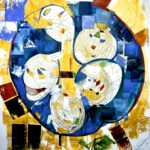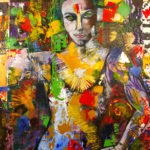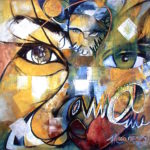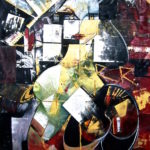PAINTINGS
M A R I A V E R O N I C A
M A R I A V E R O N I C A
M A R I A V E R O N I C A
2 O 1 5 - 2 O O O
M A R I A V E R O N I C A
M A R I A V E R O N I C A
M A R I A V E R O N I C A
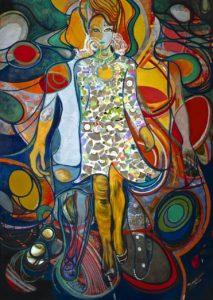
M A R I A V E R O N I C A
Supersonic Waves
M A R I A V E R O N I C A
Oil on Canvas 130x183cm, Paris 2006
M A R I A V E R O N I C A
M A R I A V E R O N I C A
M A R I A V E R O N I C A
M A R I A V E R O N I C A
M A R I A V E R O N I C A
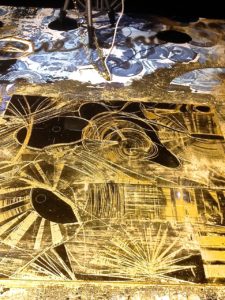
M A R I A V E R O N I C A
The Transgender Kitchen
Oil, Acrylic, Gold Podwer, Dry Point and Collage on IKEA Kitchen, Venice 2O15
M A R I A V E R O N I C A
M A R I A V E R O N I C A
M A R I A V E R O N I C A
M A R I A V E R O N I C A
M A R I A V E R O N I C A
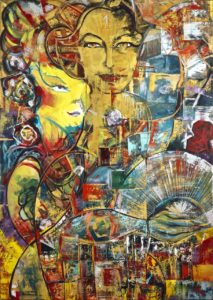
M A R I A V E R O N I C A
Through the Centuries
Oil on Canvas, Paris 2OO3
M A R I A V E R O N I C A
M A R I A V E R O N I C A
M A R I A V E R O N I C A
Maria Veronica The gold rush
M A R I A V E R O N I C A
Ileana Cornea Paris May, 2014
M A R I A V E R O N I C A
Contemporary art is rediscovering gold, this exceptional material, fascinating in its lustre and splendour, which brought glory to Ravenna and was restored to use in art by Gustave Klimt.
In the 21st century, Louise Bourgeois, Anish Kapoor, James Lee Bayars and many other artists boldly revive the tradition of the time of the pharaohs, an imperturbably enduring tradition: “gold is immortality” is the Brahmins’ constant refrain.
“Gold has no part to play in the mythologies of Homo faber.” The historian of religion, Mircea Eliade, spent his lifetime studying this question: “Gold is a creation of Homo Religiosus.” It was the first metal used by man, even though he could not use it to make tools or weapons. “Throughout History and technological innovations, from the use of stone to working bronze, then iron, and finally steel, gold has never played a part.”
Alchemists wanted to turn other metals into gold in order to cure their imperfections. Through this noble material, art touches on the sacred: “The essential symbolic value of gold has never been tainted despite the progressive desacralisation of Nature and human existence.”
There is red, black and lots of gold in Maria Veronica Léon’s painting, the enigmas of her symbolic world exploding from their fiery fusion.
Yellows, greens and blue fuse in a variety of shapes, including squares, circles, trapeziums and pentagons; they splutter into triangles and even more elastic geometric shapes. Her line unfurls such an extraordinary tangle, what can you say?
Maria Veronica Leon’s painting is disconcerting in its originality.
A willing secessionist, she eludes the golden nets she inherits from the Austrian painter who could easily have been her ancestor, but there are others before him, anonymous pre-Colombian artists from whom she gains this inheritance that binds her to the sun.
Her lyricism, freedom and courage make her different; a female artist whose attitude reminiscent of the mythical Penelope weaves her intrigues in the name of civilisation and peace.
Like the Homeric woman, she diverts her craft and directs it towards her own vital experience, thus transforming reality into legend and legend into a wonderful dream.
From the portraiture she has practised for years, she is moving towards her phantasmatic memory and from the likeness of the model to the probability of her adventure.
This is the first time she introduces animals into her painting and gems instead of faces. Men and women lose their smile, their expressions, and their weaknesses. The artist metamorphoses them into natural elements, in the first ages of humanity. When her palette darkens in a dramatic movement, incandescent red evokes the Dante-esque movement of the lava, deep, dark blue tries to calm the catastrophe, a draped silhouette stands out like a pyramid, instead of the face, a star.
Like Munch, she emphasises the voluptuous language of lines, like Beardsley she loves luxury. Her lines meet, forming her abstract geometric shapes, and this is how she conceives cities, articulating their volumes by organised agglomerations of shapes. Civilisation has a horror of the void, but the black hole is lying in wait for it. If souls petrify in a world of stars, and numbers rule the world, humanity would have to start from zero.
M A R I A V E R O N I C A
M A R I A V E R O N I C A
M A R I A V E R O N I C A
M A R I A V E R O N I C A
Locality & Aesthetics
Solo Exhibition by Maria Veronica Leon Veintemilla
Cube Arts gallery DIFC
May 14, 2014 – June 14, 2014
M A R I A V E R O N I C A
M A R I A V E R O N I C A
M A R I A V E R O N I C A
In the face of globalization and the commercial saturation of conventional societies there is a drive to create or “contrive” the new and distinct. This, in turn, leads to the formation of transcendental communion -- one such example being, the United Arab Emirates. ‘Locality & Aesthetics’ assembles works by internationally claimed artist ‘Maria Veronica’ set out for a spiritual journey, in order to seek new artistic challenges. Her paintings and drawings are reflection of the visual charm and fragrance of the “foreign region”, the pictorial translation of sunlight, and the rendering of heat, as well as the changes brought about by these phenomena in the social landscape. Locality & Aesthetics, celebrates the miracle of a poetic beauty, and puts forward the idea of the “moments of ambition”1.
-
Charles Baudelaire, Le Spleen de Paris, 1869M A R I A V E R O N I C A
Arash Amir Azodi
M A R I A V E R O N I C A
M A R I A V E R O N I C A
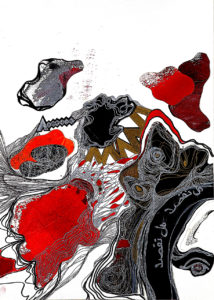
M A R I A V E R O N I C A
The Stress of The Sheikha
Acrylic and Pen on Arches, Dubai 2O14
M A R I A V E R O N I C A
M A R I A V E R O N I C A
M A R I A V E R O N I C A
M A R I A V E R O N I C A
M A R I A V E R O N I C A
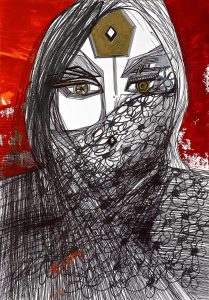
M A R I A V E R O N I C A
Hexagonal Perspective
Acrylic and Pen on Arches, Dubai 2O14
M A R I A V E R O N I C A
M A R I A V E R O N I C A
M A R I A V E R O N I C A
M A R I A V E R O N I C A
M A R I A V E R O N I C A
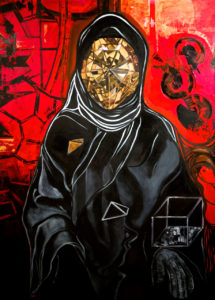
M A R I A V E R O N I C A
Sheikha Diamond
Acrylic and Oil on Canvas, Dubai 2O14
M A R I A V E R O N I C A
M A R I A V E R O N I C A
M A R I A V E R O N I C A
M A R I A V E R O N I C A
M A R I A V E R O N I C A
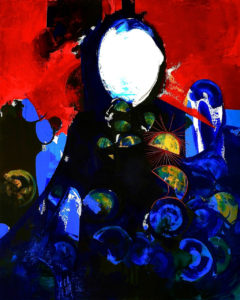
M A R I A V E R O N I C A
Sheikha Saphir
Acrylic and Oil on Canvas, Dubai 2O14
M A R I A V E R O N I C A
M A R I A V E R O N I C A
M A R I A V E R O N I C A
M A R I A V E R O N I C A
M A R I A V E R O N I C A
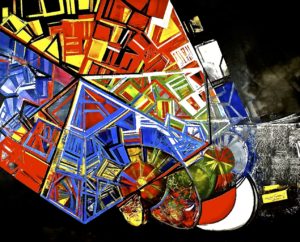
M A R I A V E R O N I C A
Dubai, The Diamond of the Region
Acrylic and Oil on Canvas, Dubai 2O14
M A R I A V E R O N I C A
M A R I A V E R O N I C A
M A R I A V E R O N I C A
M A R I A V E R O N I C A
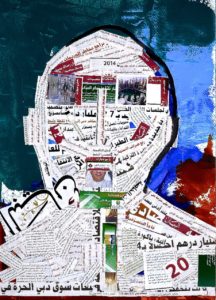
M A R I A V E R O N I C A
The Veils of the World
Collage and Painting on Arches, Dubai 2O14
M A R I A V E R O N I C A
M A R I A V E R O N I C A
M A R I A V E R O N I C A
M A R I A V E R O N I C A A
M A R I A V E R O N I C A A
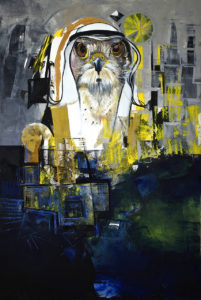
M A R I A V E R O N I C A
Times of Splendor
Acrylic and Oil on Canvas, Dubai 2O14
M A R I A V E R O N I C A
M A R I A V E R O N I C A
M A R I A V E R O N I C A
M A R I A V E R O N I C A
M A R I A V E R O N I C A
B a c k g r o u n d
M A R I A V E R O N I C A
M A R I A V E R O N I C A
M A R I A V E R O N I C A
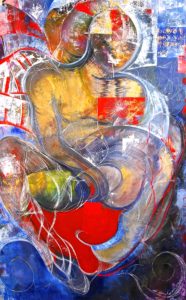
M A R I A V E R O N I C A
M A R I A V E R O N I C A
M A R I A V E R O N I C A
M A R I A V E R O N I C A
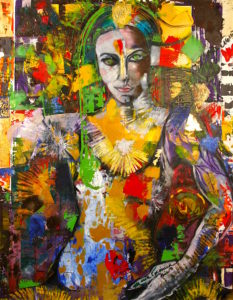
M A R I A V E R O N I C A
M A R I A V E R O N I C A
M A R I A V E R O N I C A
M A R I A V E R O N I C A
Juan Castro y Velazquez Historian and Art Critic Guayaquil Ecuador, 2002 M A R I A V E R O N I C A
In looking at the Ecuadorian contemporary art scene, we must confront the reflection of the encyclopedia of the XX century in juxtaposition with the emerging production of the contemporary artists. Confrontation is the right term to use in this instance, as the evolution of visual arts in every continent is the struggle to stay contemporary. Maria Veronica artwork has in her formal artistic language a notorious interest in taking an aspect of cubism, the "eidetic" cubism, which is based in the phenomenological thought of Edmund Husserl, about his eidetic reduction. It is a way of visual representation with advantages, especially for the colors that liberate it from the “local tonality”, much like Guy Habasque proposed in 1949. In her work she uses gold as the principal color to simplify the volume over the surface, therefore it is more illuminated. The paintings answer to a declared theme, which is evidently autobiographic, but not carrying it to an epistemological investigation, as Gleizes had described previously: The painting becomes a fact; its reality is not the reality of the mirror, but the one of the object. It is homogenous in everything, mobile and closed, and not a spectacular fragment that is open because the frame. Its beauty is not about what it says, but about what it is inside of it because it exists. The circle, like the shape of Maria Veronica Leon production, remind us of painters of The Section d’Or like Robert Delaunay and her wife Sonya Delaunay-Terk, with a very rich work in musical implications, being the circle within the Geometric Abstraction the figure with which they proposed a musical dimension of time, starting in the musical camp with a different position from the one of Wasilly Kandinsky. Kandinsky based himself in the principle of an interior necessity inspired by the Dionysiaque music of Wagner, while the painters of The Section d’Or achieved this having as starting point one more Apollonian and for instance more loyal to the principles of harmony. Over the brilliant surface of compact discs, she draws with a knife very deep lines like the traces of a print, for this reason each trace is an indelible and unchangeable mark; like a diamond cut. With this, the reflection suffers decomposition and it is dissolved like a mirror gallery, held in the palm of the hand. A way to capture the light and to leave a reiterative optical testimony, that she calls CD Art Theory (artistic theory of the CD), suspended in an interesting text. The game of mirrors in arts has a complicated genealogy, but it was notorious in Classic Antiquity, in Orient as in the Pre-Columbian America; mirrors appeared with more frequency in circular ways and in a handy size and when the reflection breaks on the water; like in Narcissus myth, we have concentric circular waves. The mirror," psyche" like as it was called in Central Europe in XIX century, is where the personality of this courageous woman appears clearly; who defend her talent and who printed in a contemporary palimpsest her own life.
M A R I A V E R O N I C A
M A R I A V E R O N I C A
M A R I A V E R O N I C A
Juan Castro y Velazquez Historian and Art Critic Guayaquil Ecuador, 2003 M A R I A V E R O N I C A María Verónica is a remarkable painter, an artist that in her early years has already a body of work sustained in a very important multidisciplinary production. In a globalized world, María Verónica works parallel to fuse two traditions that are divergent in appearance, modern art, specifically painting, and contemporary art in the extra-pictorial manifestations. Light, colour and gold take a dominant place in the chromatic of her paintings, but her leitmotiv is dance and movement, something in harmony with her personality. It is for this reason María Verónica has been dedicating part of her creation to Pina Bausch dance and the Wuppertal Tanztheater. Pina Bausch company: fusion of dance and theater with a psychological expressively and a philosophical dimension making a sketch of our existence in contemporary times. María Verónica is fast in taking the instant of the movement, and precise in capturing the nature of dancers. She uses curved lines that enlace each other, bringing out a spatial volume. When she places the relaxed point in the center of the composition, she works around to achieve the radial movement of the figures. Her drawings are not excessive in their trace and they acquire a solemn character when she uses gold applications and reflections. The painting of María Verónica is defined by a neo Baroque environment, which is distinguished even more because of the presence of gold, which remind us of the Venetian school and more particularly of Gustav Klimt. Her favourite subject is the portrait, of which she has had many commissions in Ecuador, as well as in other countries. María Verónica paints herself often. She is the painter and the model, a kind of hedonism, which is specially allowed in the art world. Her familiar portraits or double portraits of mother and daughter, talk about a particular subject in our tradition of painting. Her inclination for two of these arts, painting and dance is evident. In this way, María Verónica is inscribed in the renacentist tradition prolonged by Castiglione, who ask to be considered a gentleman (in this case a lady) of culture, the versatility of interests. It is the absolutely truth that we can know the excellence of an artist before by looking at his or her drawings, from the first gestures and traces will. María Verónica shows considerable proof of mastery in her magnificent drawings. They are of high quality, remarkable in their execution and they posed an emotional charge to perceive the generous spirit of her creator. The movement captured in drawing is something very difficult for a visual artist. María Verónica achieves this. Through her condition of contemporary artist and dilettante of dance, this young woman, mundane and willful, who works in the magnificent and luxurious Paris, shows us a multidisciplinary creation without precedents in Ecuadorian art history. Exceptional exhibitions are possible thanks to the courage of this young Ecuadorian lady, daughter of our Litoral and pride of our culture. V E R O N I C A
M A R I A V E R O N I C A
M A R I A V E R O N I C A
M A R I A V E R O N I C A
M A R I A V E R O N I C A
M A R I A V E R O N I C A
M A R I A V E R O N I C A
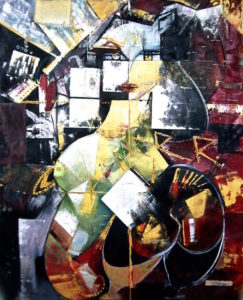
SERHGKJHULJLKJLHLKJL
En la Plaza de la Paletta corro yo, Toro, Gata y Mujer Artista
M A R I A V E R O N I C A
M A R I A V E R O N I C A
M A R I A V E R O N I C A
Marc Debergh Historien and Art Critic Paris, 2OO1
M A R I A V E R O N I C A The work of Maria Veronica Leon V. has developed in recent years towards three axes. M A R I A V E R O N I C A First axis: The neo-surrealist atmosphere painting on the themes of fertile bodies, all in lines and lines expressing the love of life, in the concentration of effects with implicit references to Bellmer on certain points, to Leonor Fini in finesse and refinement, to the art of movement (music and dance). These paintings, which are closely linked to engraving, delight connoisseurs and are complemented by an important body of drawings. M A R I A V E R O N I C A A second axis, also noticed in Paris at the Galerie de Nesle and Unesco, highlights the decisive brush stroke of the Ecuadorian artist -peintre first in a stunning series of portraits just as realistic as gracious in a pose and a mysterious atmosphere almost sacred: it is the case of some masterpieces as the Empress of China, a sort of self-portrait transformed and reborn in a Hispano-sirio-Inca process and the famous singer Bjork, fantastic in its relation to the contemporary world set in the cosmos. M A R I A V E R O N I C A The tones of these paintings are all strong, the great green of the Eastern tradition of the Empress with its black and red accents, green and brown dancers; blue, mauve elsewhere. The presences sprung from the painting, in the almost iconic portrait of Adjani, and in dozens of others, which have been seen in numerous international exhibitions in Paris, New York, Quito, Beijing, Havana, Quebec, Wuppertal , Venice. M A R I A V E R O N I C A And again the bursting burst of the Year 2001, the entry into the third millennium, under the gaze of the Inca. This is the third major direction, fully operative in the creative impulse of the new century: the large canvases of the Inca Deities looking at our contemporary, virtual, trans-active world. M A R I A V E R O N I C A Six or seven decisive works, worthy of the great museums open to the history of cultures and the future of the hieratic and dynamic eye and work in their relationship to space, light, nuanced palette complex and yet dominated colors, assimilating Rayonism, Orphism, transcultural symbolism of the Inca and Hispanic worlds. M A R I A V E R O N I C A Human works, feminine in depth, of such a richness that it is derisory to situate them only in a few lines, which shake the status quo around this side of the contemporary painting, post traditional, and mechanical painting of the new technologies. bold criticism under the gaze of the Inca of postindustrial conformism, flooded advertisements (CDs) and agreed coldness, and at the same time technical mastery of the pictorial material, which gives life to manual painting, optical and efficient paint causes the participation of look and impressions. These works have an Inca effect of the third millennium, exhibited in Paris in spaces Bill Tornade, and Sylvie Rielle. They are the confirmation of her innovative talent; all at the same time built on classic foundations and constantly creative. M A R I A V E R O N I C A Maria Veronica, one of the greatest women painters of our times, that is to say, and the XX and XXI century; a woman of ultra-luminous consciousness who installs a symbolic, lyrical and expressionist triangle between American Indian and European creation -vision and the new art of loving, regenerating and transcending our world. Shapes, colors, calligraphy, faces and signs. Humanity and mystery of the beyond unconcluded summarizes in this word that often comes up, written on the paintings, amor, love, with different vibratory intonations.
M A R I A V E R O N I C A
M A R I A V E R O N I C A
M A R I A V E R O N I C
Marc Debergh Historien et Critique d’Art Paris, 2OO1
M A R I A V E R O N I C A
L'œuvre de Maria Veronica Leon V. s 'est développée ces dernières années vers trois axes.
M A R I A V E R O N I C A
Premier axe : La peinture d'atmosphère néo surréaliste sur les thèmes des corps fertiles, tout en traits et en lignes exprimant l'amour de la vie, dans la concentration des effets avec des références implicites à Bellmer sur certains points, à Leonor Fini dans la finesse et le raffinement, à l'art du mouvement (musique et danse). Ces peintures très liées à la gravure font la joie des connaisseurs et sont complétées par un important corpus des dessins.
M A R I A V E R O N I C A
Un deuxième axe, remarqué aussi à Paris, à la Galerie de Nesle et à l' Unesco, met en relief le coup de pinceau décisif de l' artiste -peintre équatorienne de premier rang dans une étonnante série de portraits tout autant réalistes que gracieux dans une pose et une atmosphère mystérieuse presque sacrale: ce sont les cas de quelques chefs d'oeuvre comme L'Impératrice de Chine,sorte d'autoportrait transfiguré et réincarné dans un processus Hispano-sirio-inca et la célèbre chanteuse Bjork, fantastique dans son rapport au monde contemporain serti dans le cosmos.
M A R I A V E R O N I C A
Les tonalités de ces peintures sont toutes fortes, le grand vert de la tradition orientale de l'Impératrice avec ses accents noirs et rouges, les verts et les bruns chez les danseuses; le bleu, le mauve ailleurs. Les présences jaillies du tableau, dans le portrait d' Adjani, presque iconique et dans des dizaines d autres, qui ont été vues dans des nombreuses expositions a retentissement international à Paris, New York, `Quito, Beijing, La Havane, Québec, Wuppertal, Venise.
M A R I A V E R O N I C A
Et de nouveau le jaillissement éclatant de l'Année 2001, l'entrée dans le troisième millénaire, sous le regard de l'Inca. C'est la troisième direction majeure, pleinement opérative dans l'élan créateur du nouveau siècle: les grandes toiles des Divinités Inca regardant notre monde contemporain, virtuel, trans-actif.
M A R I A V E R O N I C A
Six ou sept oeuvres décisives, dignes des grands musées ouverts sur l'histoire des cultures et l'avenir de l'oeil et de la main-oeuvres hiératiques et dynamiques dans leur rapport à l'espace, à la lumière, à la palette nuancée,complexe et cependant dominée des couleurs, assimilant le rayonnisme, l'orphisme, les symbolismes transculturels des mondes incas et hispaniques.
M A R I A V E R O N I C A
Oeuvres humaines, féminines en profondeur, d'une telle richesse qu'il est dérisoire de les situer uniquement en quelques lignes, qui ébranlent le statu quo autour de ce versant de la peinture contemporaine, post traditionnelle, et peinture mécanique des nouvelles technologies. Critique hardie sous le regard de l'Inca du conformisme postindustriel, inondé de publicités (CDs) et des froideurs convenues, et en même temps maîtrise technique de la matière picturale, qui redonne vie à la peinture manuelle, peinture optique et efficiente qui entraîne la participation du regard et des impressions. Ces oeuvres ont un effet Inca du troisième millénaire, exposées à Paris dans les espaces Bill Tornade, et Sylvie Rielle. Elles sont la confirmation du talent innovateur; tout à la fois bâties sur des assises classiques et sans cesse créatives.
M A R I A V E R O N I C A
Maria Veronica, une des plus grandes femmes peintres de notre temps, c'est a dire et du XX et XXI siécle; femme de conscience ultra lumineuse qu'installe un triangle symbolique, lyrique et expressionniste entre la création -vision amérindienne et européenne et le nouvel art d'aimer notre monde, le régénérer et le dépasser. Formes, couleurs, calligraphies, visages et signes. Humanité et mystère des au delà non clos résume dans ce mot qui revient souvent, écrit sur les tableaux, amor, amour, avec différentes intonations vibratoires.
M A R I A V E R O N
M A R I A V E R O N I C A
M A R I A V E R O N
M A R I A V E R O N I C A
Marc Debergh Historiador y Critico de Arte Paris, 2OO1
M A R I A V E R O N I C A
El trabajo de María Verónica León V. ha desarrollado en los últimos años a partir de tres ejes.
M A R I A V E R O N I C A
El primero, la pintura de atmósfera neo-surrealista con temas de cuerpos fértiles, todo esto en trazos y líneas que expresan el amor por la vida, en la concentración de efectos con referencias implícitas en ciertos casos a Bellmer, a Leonor Fini por su delicadeza y refinamiento y al arte del movimiento (música y danza). Estas pinturas, que están estrechamente conectadas con el grabado causan el deleite de expertos y se complementan con un importante cuerpo de dibujos.
M A R I A V E R O N I C A
Un segundo eje, asi tambien destacado en París en la Galerie de Nesle y en la UNESCO, pone de relieve la pincelada decisiva de la artista-pintora ecuatoriana de primer rango en una sorprendente serie de retratos tanto realistas como graciosos en poses y atmósferas misteriosas casi sagradas: es el caso de algunas obras maestras como la Emperatriz de China, una especie de autorretrato transfigurado y reincarnado en un proceso Hispano-sirio-Inca, y la famosa cantante Bjork, fantástica en su relación con el mundo contemporaneo ambientado en el cosmos.
M A R I A V E R O N I C A
Las tonalidades de estas pinturas son intensas, el gran verde de la tradición oriental de la Emperatriz con sus acentos negros y rojos, los verdes y marrones de sus bailarines; el azul, y el púrpura por cierto. Personalidades que emergen de su pintura, en el retrato casi icónico de Adjani, y de una decena mas, las mismas que han sido admiradas en numerosas exposiciones internacionales en París, Nueva York, Quito, Pekín, La Habana, Quebec, Wuppertal, Venecia.
M A R I A V E R O N I C A
Y de nuevo, el estallido luminoso del año 2001, la entrada en el tercer milenio bajo la mirada del Inca. Esta es la tercera dirección mayor, plenamente operativa en el impetu creativo del nuevo siglo: los grandes lienzos de las Diosas Incas observando nuestro mundo contemporáneo, virtual y transactivo.
M A R I A V E R O N I C A
Seis o siete obras decisivas, dignas de grandes museos abiertos a la historia de la culturas del mundo y asi tambien al futuro del ojo y de la mano; obras hieráticas y dinámicas en su relación con el espacio, con la luz y la paleta matizada, compleja, dominada por los colores, y asimilando el Rayonismo, el orfismo, los simbolismos transculturales de los mundos Inca e Hispanico.
M A R I A V E R O N I C A
Obras humanas, femeninas en escencia, de tal riqueza que es irrisorio situarlas en pocas líneas, que hacen temblar el status quo en torno a esta vertiente de la pintura contemporánea, post-tradicional, y pintura mecánica de las nuevas tecnologías. Crítica audaz bajo la mirada del Inca sobre el conformismo postindustrial, inundado de publicidad (CDs) y de frialdades convenidas, mostrando al mismo tiempo una maestria técnica de la materia pictórica y que da vida a la pintura manual; pintura óptica y eficiente que involucra la participación del observador y sus impresiones. Estas obras, que tienen un efecto Inca del tercer milenio, expuestas en París en Bill Tornade y Sylvie Rielle, son la confirmación de su talento innovador; construido sobre fundamentos clásicos y al mismo tiempo creativas sin cesar.
M A R I A V E R O N I C A
María Verónica, una de las mujeres pintoras más grandes de nuestro tiempo, es decir del siglo XX y XXI; es una mujer de conciencia ultra-luminosa que instala un triangulo simbolico, lirico y expresionista entre la creacion - vision indio americana y europea y el nuevo arte de amar nuestro mundo, de regenerarlo y de superarlo. Formas, colores, caligrafía, rostros y signos. La humanidad y el misterio sin resolver del más allá se resumen en una palabra que a menudo aparece escrita en sus pinturas: amor, amour, con diferentes entonaciones vibratorias.M A R I A V E R O N I C A
M A R I A V E R O N I C A
M A R I A V E R O N I C A
M A R I A V E R O N I C A
No Comments